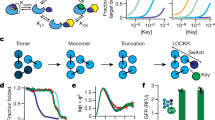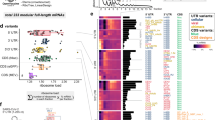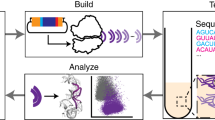Abstract
Peptides that contain β-amino acids display stable secondary structures, such as helices and sheets, and are often referred to as foldamers. Cyclic β2,3-amino acids (cβAAs), such as 2-aminocyclohexanecarboxylic acid (2-ACHC), are strong helix/turn inducers due to their restricted conformations. Here we report the ribosomal synthesis of foldamer peptides that contain multiple, up to ten, consecutive cβAAs via genetic code reprogramming. We also report the de novo discovery of macrocyclic cβAA-containing peptides capable of binding to a protein target. As a demonstration, potent binders with low-to-subnanomolar KD values were identified for human factor XIIa (hFXIIa) and interferon-gamma receptor 1, from a library of their 1012 members. One of the anti-hFXIIa macrocyclic peptides that exhibited a high inhibitory activity and serum stability was co-crystallized with hFXIIa. The X-ray structure revealed that it adopts an antiparallel β-sheet structure induced by a (1S,2S)-2-ACHC residue via the formation of two γ-turns. This work demonstrates the potential of this platform to explore the previously inaccessible sequence space of cβAA-containing peptides.

This is a preview of subscription content, access via your institution
Access options
Access Nature and 54 other Nature Portfolio journals
Get Nature+, our best-value online-access subscription
$29.99 / 30 days
cancel any time
Subscribe to this journal
Receive 12 print issues and online access
$259.00 per year
only $21.58 per issue
Buy this article
- Purchase on Springer Link
- Instant access to full article PDF
Prices may be subject to local taxes which are calculated during checkout




Similar content being viewed by others
Data availability
Coordinates and structure factors have been deposited in the Protein Data Bank, under accession no. 6L63. Other data supporting this study are available in the Supplementary Information.
References
Kudo, F., Miyanaga, A. & Eguchi, T. Biosynthesis of natural products containing β-amino acids. Nat. Prod. Rep. 31, 1056–1073 (2014).
Cabrele, C., Martinek, T. A., Reiser, O. & Berlicki, Ł. Peptides containing β-amino acid patterns: challenges and successes in medicinal chemistry. J. Med. Chem. 57, 9718–9739 (2014).
Schumann, F., Müller, A., Koksch, M., Müller, G. & Sewald, N. Are β-amino acids γ-turn mimetics? Exploring a new design principle for bioactive cyclopeptides. J. Am. Chem. Soc. 122, 12009–12010 (2000).
Strijowski, U. & Sewald, N. Structural properties of cyclic peptides containing cis- or trans-2-aminocyclohexane carboxylic acid. Org. Biomol. Chem. 2, 1105–1109 (2004).
Malešević, M. et al. Spectroscopic detection of pseudo-turns in homodetic cyclic penta- and hexapeptides comprising β-homoproline. Int. J. Pept. Res. Ther. 12, 165–177 (2006).
Guthohrlein, E. W., Malesevic, M., Majer, Z. & Sewald, N. Secondary structure inducing potential of β-amino acids: torsion angle clustering facilitates comparison and analysis of the conformation during MD trajectories. Biopolymers 88, 829–839 (2007).
Appella, D. H., Christianson, L. A., Karle, I. L., Powell, D. R. & Gellman, S. H. β-peptide foldamers: robust helix formation in a new family of β-amino acid oligomers. J. Am. Chem. Soc. 118, 13071–13072 (1996).
Appella, D. H. et al. Residue-based control of helix shape in β-peptide oligomers. Nature 387, 381–384 (1997).
Checco, J. W. et al. α/β-peptide foldamers targeting intracellular protein–protein interactions with activity in living cells. J. Am. Chem. Soc. 137, 11365–11375 (2015).
Langer, O., Kahlig, H., Zierler-Gould, K., Bats, J. W. & Mulzer, J. A bicyclic cispentacin derivative as a novel reverse turn inducer in a GnRH mimetic. J. Org. Chem. 67, 6878–6883 (2002).
Gopalan, R. D., Del Borgo, M. P., Mechler, A. I., Perlmutter, P. & Aguilar, M. I. Geometrically precise building blocks: the self-assembly of β-peptides. Chem. Biol. 22, 1417–1423 (2015).
Kwon, S. et al. Magnetotactic molecular architectures from self-assembly of β-peptide foldamers. Nat. Commun. 6, 8747 (2015).
Seoudi, R. S. & Mechler, A. Design principles of peptide based self-assembled nanomaterials. Adv. Exp. Med. Biol. 1030, 51–94 (2017).
Müller, M. M. Post-translational modifications of protein backbones: unique functions, mechanisms, and challenges. Biochemistry 57, 177–185 (2017).
Walsh, C. T., O’Brien, R. V. & Khosla, C. Nonproteinogenic amino acid building blocks for nonribosomal peptide and hybrid polyketide scaffolds. Angew. Chem. Int. Ed. 52, 7098–7124 (2013).
Dedkova, L. M. et al. β-puromycin selection of modified ribosomes for in vitro incorporation of β-amino acids. Biochemistry 51, 401–415 (2011).
Maini, R. et al. Incorporation of β-amino acids into dihydrofolate reductase by ribosomes having modifications in the peptidyltransferase center. Bioorg. Med. Chem. 21, 1088–1096 (2013).
Maini, R. et al. Protein synthesis with ribosomes selected for the incorporation of β-amino acids. Biochemistry 54, 3694–3706 (2015).
Czekster, C. M., Robertson, W. E., Walker, A. S., Soll, D. & Schepartz, A. In vivo biosynthesis of a β-amino acid-containing protein. J. Am. Chem. Soc. 138, 5194–5197 (2016).
Fujino, T., Goto, Y., Suga, H. & Murakami, H. Ribosomal synthesis of peptides with multiple β-amino acids. J. Am. Chem. Soc. 138, 1962–1969 (2016).
Iqbal, E. S., Dods, K. K. & Hartman, M. C. T. Ribosomal incorporation of backbone modified amino acids via an editing-deficient aminoacyl-tRNA synthetase. Org. Biomol. Chem. 16, 1073–1078 (2018).
Katoh, T. & Suga, H. Ribosomal incorporation of consecutive β-amino acids. J. Am. Chem. Soc. 140, 12159–12167 (2018).
Katoh, T., Wohlgemuth, I., Nagano, M., Rodnina, M. V. & Suga, H. Essential structural elements in tRNA(Pro) for EF-P-mediated alleviation of translation stalling. Nat. Commun. 7, 11657 (2016).
Dale, T., Sanderson, L. E. & Uhlenbeck, O. C. The affinity of elongation factor Tu for an aminoacyl-tRNA is modulated by the esterified amino acid. Biochemistry 43, 6159–6166 (2004).
Dale, T. & Uhlenbeck, O. C. Amino acid specificity in translation. Trends Biochem. Sci. 30, 659–665 (2005).
Goto, Y., Katoh, T. & Suga, H. Flexizymes for genetic code reprogramming. Nat. Protocols 6, 779–790 (2011).
Katoh, T., Tajima, K. & Suga, H. Consecutive elongation of d-amino acids in translation. Cell Chem. Biol. 24, 1–9 (2017).
Katoh, T., Iwane, Y. & Suga, H. Logical engineering of D-arm and T-stem of tRNA that enhances d-amino acid incorporation. Nucleic Acids Res. 45, 12601–12610 (2017).
Kwon, S., Jeon, A., Yoo, S. H., Chung, I. S. & Lee, H. S. Unprecedented molecular architectures by the controlled self-assembly of a β-peptide foldamer. Angew. Chem. Int. Ed. 49, 8232–8236 (2010).
Kim, J. et al. Microtubes with rectangular cross-section by self-assembly of a short β-peptide foldamer. J. Am. Chem. Soc. 134, 20573–20576 (2012).
Schmitt, M. A., Choi, S. H., Guzei, I. A. & Gellman, S. H. New helical foldamers: heterogeneous backbones with 1:2 and 2:1 α:β-amino acid residue patterns. J. Am. Chem. Soc. 128, 4538–4539 (2006).
Yamagishi, Y. et al. Natural product-like macrocyclic N-methyl-peptide inhibitors against a ubiquitin ligase uncovered from a ribosome-expressed de novo library. Chem. Biol. 18, 1562–1570 (2011).
Passioura, T., Katoh, T., Goto, Y. & Suga, H. Selection-based discovery of druglike macrocyclic peptides. Annu. Rev. Biochem. 83, 727–752 (2014).
Maas, C. & Renné, T. Coagulation factor XII in thrombosis and inflammation. Blood 131, 1903–1909 (2018).
Nickel, K. F., Long, A. T., Fuchs, T. A., Butler, L. M. & Renné, T. Factor XII as a therapeutic target in thromboembolic and inflammatory diseases. Arterioscler. Thromb. Vasc. Biol. 37, 13–20 (2017).
Green, D. S., Young, H. A. & Valencia, J. C. Current prospects of type II interferon gamma signaling and autoimmunity. J. Biol. Chem. 292, 13925–13933 (2017).
Schroder, K., Hertzog, P. J., Ravasi, T. & Hume, D. A. Interferon-γ: an overview of signals, mechanisms and functions. J. Leukoc. Biol. 75, 163–189 (2004).
Mujtaba, M. G. et al. The gamma interferon (IFN-γ) mimetic peptide IFN-γ (95–133) prevents Encephalomyocarditis virus infection both in tissue culture and in mice. Clin. Vaccine Immunol. 13, 944–952 (2006).
Hojima, Y., Pierce, J. V. & Pisano, J. J. Hageman factor fragment inhibitor in corn seeds: purification and characterization. Thromb. Res. 20, 149–162 (1980).
Farady, C. J. & Craik, C. S. Mechanisms of macromolecular protease inhibitors. ChemBioChem 11, 2341–2346 (2010).
Laskowski, M. & Kato, I. Protein inhibitors of proteinases. Annu. Rev. Biochem. 49, 593–626 (1980).
Pathak, M. et al. Coagulation factor XII protease domain crystal structure. J. Thromb. Haemost. 13, 580–591 (2015).
Baeriswyl, V. et al. A synthetic factor XIIa inhibitor blocks selectively intrinsic coagulation initiation. ACS Chem. Biol. 10, 1861–1870 (2015).
Pathak, M. et al. Crystal structures of the recombinant β-factor XIIa protease with bound Thr-Arg and Pro-Arg substrate mimetics. Acta Crystallogr. D 75, 578–591 (2019).
Middendorp, S. J. et al. Peptide macrocycle inhibitor of coagulation factor XII with subnanomolar affinity and high target selectivity. J. Med. Chem. 60, 1151–1158 (2017).
Song, H. K. & Suh, S. W. Kunitz-type soybean trypsin inhibitor revisited: refined structure of its complex with porcine trypsin reveals an insight into the interaction between a homologous inhibitor from Erythrina caffra and tissue-type plasminogen activator. J. Mol. Biol. 275, 347–363 (1998).
Perona, J. J., Tsu, C. A., Craik, C. S. & Fletterick, R. J. Crystal structures of rat anionic trypsin complexed with the protein inhibitors APPI and BPTI. J. Mol. Biol. 230, 919–933 (1993).
Ibrahim, B. S. & Pattabhi, V. Crystal structure of trypsin–turkey egg white inhibitor complex. Biochem. Biophys. Res. Commun. 313, 8–16 (2004).
Murakami, H., Ohta, A., Ashigai, H. & Suga, H. A highly flexible tRNA acylation method for non-natural polypeptide synthesis. Nat. Methods 3, 357–359 (2006).
Saito, H., Kourouklis, D. & Suga, H. An in vitro evolved precursor tRNA with aminoacylation activity. EMBO J. 20, 1797–1806 (2001).
Hirata, K. et al. Achievement of protein micro-crystallography at SPring-8 beamline BL32XU. J. Phys. Conf. Ser. 425, 012002 (2013).
Hirata, K. et al. ZOO: an automatic data-collection system for high-throughput structure analysis in protein microcrystallography. Acta Crystallogr. D 75, 138–150 (2019).
Kabsch, W. XDS. Acta Crystallogr. D 66, 125–132 (2010).
Yamashita, K., Hirata, K. & Yamamoto, M. KAMO: towards automated data processing for microcrystals. Acta Crystallogr. D 74, 441–449 (2018).
McCoy, A. J. et al. Phaser crystallographic software. J. Appl. Crystallogr. 40, 658–674 (2007).
Dementiev, A. et al. Structures of human plasma beta-factor XIIa cocrystallized with potent inhibitors. Blood Adv. 2, 549–558 (2018).
Emsley, P., Lohkamp, B., Scott, W. G. & Cowtan, K. Features and development of Coot. Acta Crystallogr. D 66, 486–501 (2010).
Adams, P. D. et al. PHENIX: a comprehensive Python-based system for macromolecular structure solution. Acta Crystallogr. D 66, 213–221 (2010).
Krissinel, E. & Henrick, K. Inference of macromolecular assemblies from crystalline state. J. Mol. Biol. 372, 774–797 (2007).
Acknowledgements
We thank H. Peacock for proofreading the manuscript. This work was supported by the Japan Society for the Promotion of Science (JSPS) Grant-in-Aid for Scientific Research (B) (18H02080); Japan Science and Technology Agency (JST) PRESTO of Molecular Technology and Creation of New Functions (JPMJPR14K3); JST CREST Rising Star Award of Molecular Technology to T.K.; JST CREST of Molecular Technologies (JPMJCR12L2) and Japan Agency for Medical Research and Development (AMED), Platform Project for Supporting Drug Discovery and Life Science Research (Basis for Supporting Innovative Drug Discovery and Life Science Research) under JP19am0101090 to H.S.
Author information
Authors and Affiliations
Contributions
All authors contributed to writing this work. T.K. carried out the experiments in all sections except for the X-ray crystallography. T.S. and K.H. carried out the X-ray crystallography. K.O. supervised the X-ray crystallography. H.S. directed the programme.
Corresponding authors
Ethics declarations
Competing interests
The authors declare no competing interests.
Additional information
Publisher’s note Springer Nature remains neutral with regard to jurisdictional claims in published maps and institutional affiliations.
Supplementary information
Supplementary Information
Supplementary Figs. 1–22, Tables 1, 3 and 4, and Results 1 and 2.
Supplementary Tables 2 and 5
Peptide and DNA sequences obtained by the next-generation sequencing and list of RNAs and corresponding primers.
Rights and permissions
About this article
Cite this article
Katoh, T., Sengoku, T., Hirata, K. et al. Ribosomal synthesis and de novo discovery of bioactive foldamer peptides containing cyclic β-amino acids. Nat. Chem. 12, 1081–1088 (2020). https://doi.org/10.1038/s41557-020-0525-1
Received:
Accepted:
Published:
Issue Date:
DOI: https://doi.org/10.1038/s41557-020-0525-1
This article is cited by
-
Community science designed ribosomes with beneficial phenotypes
Nature Communications (2023)
-
In vitro selection of macrocyclic peptide inhibitors containing cyclic γ2,4-amino acids targeting the SARS-CoV-2 main protease
Nature Chemistry (2023)
-
Expanding the substrate scope of pyrrolysyl-transfer RNA synthetase enzymes to include non-α-amino acids in vitro and in vivo
Nature Chemistry (2023)
-
Discovery of type II polyketide synthase-like enzymes for the biosynthesis of cispentacin
Nature Communications (2023)
-
Atomistic simulations of the Escherichia coli ribosome provide selection criteria for translationally active substrates
Nature Chemistry (2023)



